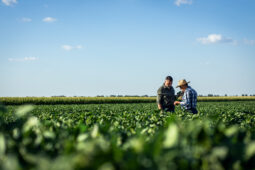Blog Series Part 2 of 3: Flexibility and Ease of Use
In part-one of this series, we looked at the different types of ag microbials and the advantages of using native microbes to benefit the plant and all cycles of crop development, over the process of introducing non-native microbes into the soil. In this post, we’ll consider some of the different challenges with handling and applying biologicals, as well as some other key differentiators in the marketplace.
Microbial Management Practices
Some microorganisms used in agronomic biologicals are quite delicate and come with special handling and application instructions to ensure that they remain alive and effective. To the grower, this translates into extra work beyond the best practices they’re already using to run their farm. Biologicals may need to be stored cold or they may need to be “activated” on site to bring up the concentration of good bacteria to effective levels. They may also have usage restrictions based on incompatibility with certain fertilizers or agrochemicals. These considerations will vary by product, but the general rule of thumb remains that adding a biological often requires a disruption to the grower’s standard routine.
This is another area where the BiOWiSH HoloGene 3™ technology shines – its ease of use. This technology doesn’t just partner with the plant’s natural processes (as discussed in part-one of this series), but it also partners with the grower’s standard management practices. With BiOWiSH® microbials, growers don’t have to worry about extra steps or special handling measures, nor added costs associated with those supplemental on-farm applications. Better yet, BiOWiSH® Crop Liquid also offers flexible options for application.
BiOWiSH® organisms are specifically selected based on their industry-leading shelf-life, versatility as dry fertilizer coatings, and ability to be mixed with liquid fertilizer. This gives the grower complete flexibility to incorporate microbials into their current nutrient management program. From there, these microbes work to help to improve nutrient uptake and overall nutrient use efficiency.
This ease of use, and the fact that BiOWiSH HoloGene 3™ technology is incorporated with fertilizers, calls to mind another class of agronomic products – Enhanced Efficiency Fertilizers (EEF). EEFs are fertilizer products with characteristics that allow increased nutrient availability and reduce potential of nutrient losses to the environment when compared to an appropriate reference product, as defined by the Association of American Plant Food Control Officials (AAPFCO).
Familiar EEF products include urease and nitrification inhibitors (which inhibit chemical loss pathways for fertilizer N), controlled release polymer coatings (which titrate nutrients into the environment slowly over time), and micronutrient additives. These products all have several things in common: they work through a single mode of action, address a single nutrient, and address the challenge of keeping nutrients in the soil where they’re available to the plant.
BiOWiSH HoloGene 3™ technology, however, represents a new type of EEF, one which addresses the challenge of delivering soil nutrients through the roots to where they’re needed instead of just ensuring that they stay in the soil. Unlike traditional Enhanced Efficiency Fertilizers, the BiOWiSH® approach addresses multiple nutrients and presents multiple nutrient-related and nutrient-independent modes of action.
The BiOWiSH® benefits extend beyond the soil and into the soil microbiome. Because of these unique, diverse modes of action, and the fact that there is currently no classification of EEF that includes microbial products with our modes of action, BiOWiSH® Crop Liquid is in a new class, a class of its own. It has an extended shelf-life and it’s added to the fertilizer, making the microbial easy to apply, while also improving the effectiveness of the fertilizer at the same time.
Effective and easy? That’s our aim… and we’re pretty proud of it.
In the next post, we’ll address the grower’s final challenge- making sure the microbial they’ve selected is a quality product and formulated as advertised on the label. This may be the biggest reason why all agronomic microbials are not created equally.
Author
John Gorsuch
Director of R&D
BiOWISH Technologies Inc.
Cincinnati, Ohio 45208 USA





